Long Island Rail Road Anecdotes 
|
|
Book of Rules Training
by Steve Torborg |
|
Last day of my last two year Book of Rules training. This time next
year, I should be a month or so from retirement!
It's funny how people who don't work for the railroad, and even many who
do, have no idea what conductors and engineers go through just to keep
their jobs.
In my 27 years, I've done this a dozen times. First when you hire on,
it's a barrage of training and testing, just to get the job. Then in 2-3
years, you do it all over again in order to "qualify" and keep the job.
Then you do it again every two years until you retire, quit or die.
The training is mandatory, no less that a full week of training, 10-12
different topics, 6-8 different tests, all of which you MUST pass in
order to simply keep your job. Then there's the periodic other items
you're schooled and tested on annually, again pass or you're on the
street, regardless of longevity. All this while possessing a federal
license that "allows" you to do your job, but also makes you susceptible
to criminal charges and huge fines should you make a mistake.
I love my job, in spite of all the testing, in spite of the constant
threats of violence and terrorism, in spite of the fact that people get
injured, crippled and killed on this job regularly, and in spite of the
constant changes that make it more of challenge than ever before.
So, before you talk about how conductors and engineers don't do crap,
are paid too much, are complete morons or any number of other regular
insults we hear, walk a mile in our shoes. Absorb all the information we
have to commit to memory, take responsibility for a thousand people
moving along at 80 miles per hour, and accept annual and biannual
mandatory testing that puts your job on the line. We have some
"difficult" people here for sure, but never underestimate the knowledge
they possess or the responsibility they knowingly accept!
May 2023 Steve Torborg |
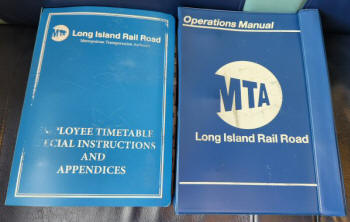 |
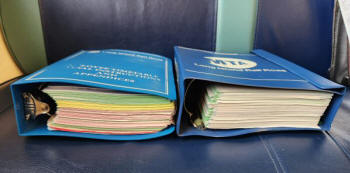
Timetable, Book of Rules, Train Handling and Equipment Manual (THEM)
required reading! Steve Torborg |
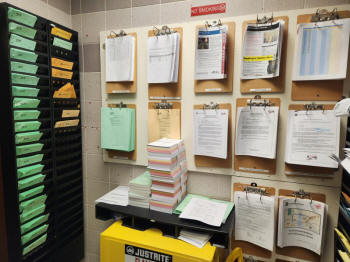
Long Beach daily bulletin board for
required check-in and to be compliant with daily! |
|
Twice a year, all conductors and engineers have to
"pick" new jobs (assignments). When this occurs, there's also the
implementation of schedule revisions. These revisions include updating
all of the paperwork we have to carry, specifically the timetable, book
of rules and train handling equipment manual (THEM). This Season's
"pick" and revisions go into effect on Monday, May 22, 2023. Paperwork
changes include what's in the photo. White, yellow and pink pages
replace the schedules for weekdays (white) and weekends (yellow), while
pink pages replace the special instructions. The additional white pages
are updated replacement pages for the book of rules and THEM manual.
Then you have the green pages which are general notices. They update
anything and everything on an as needed basis. The rest of the yellow,
beige and green pages are new cover pages, infrastructure improvement
work and bulletin notices, all of which are also updates weekly or
daily. The job includes a LOT of paperwork! May 2023 Steve
Torborg |
|
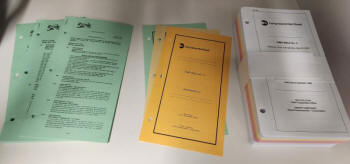
Green General notices. yellow, beige and green pages are new cover pages
for infrastructure improvement work and bulletin notices.
Pictures/Archive: Steve Torborg |
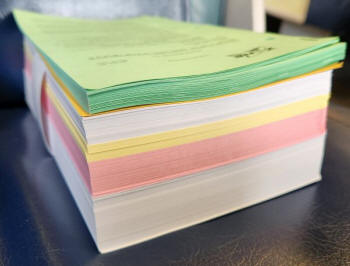
|
|
|
Jamaica
Station Lockers
by Brad Phillips
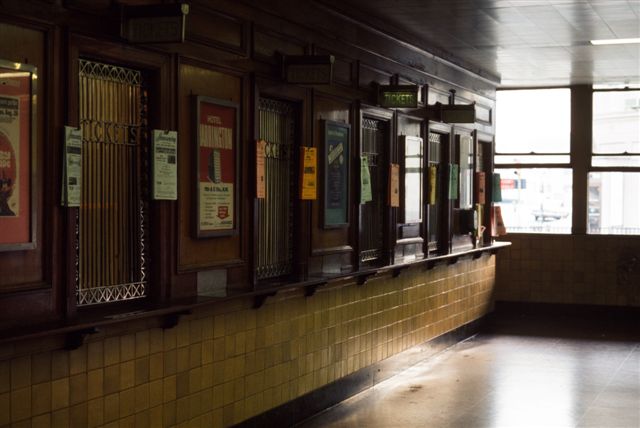 |
|
Ah, the Jamaica lockers. I haven't thought of them for eons.
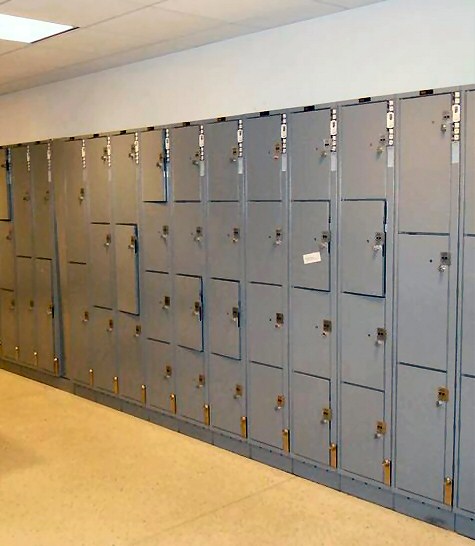 As an extra board ticket seller during the summers of the late 1960's, I often covered the
12 noon-8 p.m. job at Jamaica while the regular man was on vacation. This job not only sold tickets, but had responsibility for a wide assortment of interesting (?) tasks. I maintained the ticket stock room in the basement, collected cash from the pay toilets As an extra board ticket seller during the summers of the late 1960's, I often covered the
12 noon-8 p.m. job at Jamaica while the regular man was on vacation. This job not only sold tickets, but had responsibility for a wide assortment of interesting (?) tasks. I maintained the ticket stock room in the basement, collected cash from the pay toilets
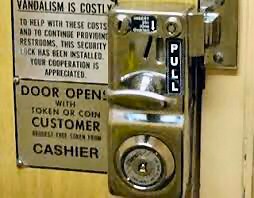 (remember them?) and penny scale in the waiting room (I should have taken a photo of that baby), and .... was in charge of the several banks of storage lockers in the concourse.
(remember them?) and penny scale in the waiting room (I should have taken a photo of that baby), and .... was in charge of the several banks of storage lockers in the concourse.
The regular man took a "leisurely" approach to enforcing the time limits, allowing non-paying users several free days before finally putting a "plug" in the lock when items where still not removed or more money inserted. Rarely were items removed for non-payment as they would have to be boxed up and sent to Flatbush Avenue for eventual claim by owners or disposition, a real pain-in-the-xxx job.
Being young and gung-ho to impress my boss, station agent Gene Maraz (sp?), I decided to follow the rules to the letter. No more of these free days to the slackers of Archer Avenue!
|
|
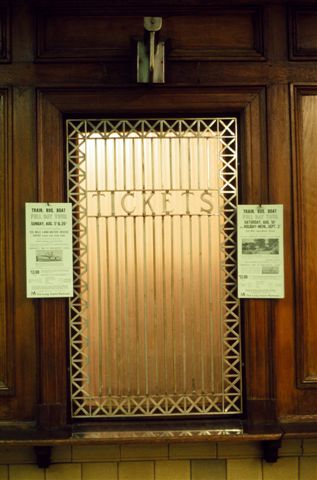 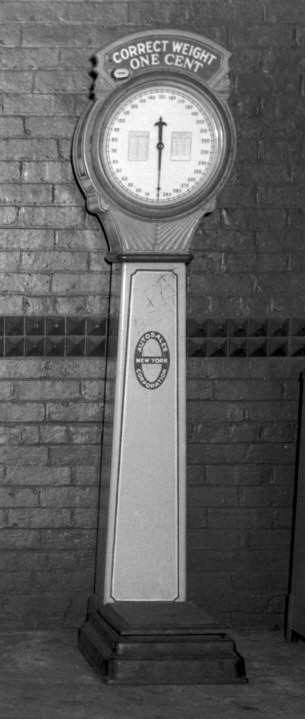 Well, the guys up in accounting wondered where all the storage money was coming from! With me doing all the sweaty work of boxing up abandoned belongings, I think Gene was more amused than impressed with my efforts. The other ticket sellers were mostly annoyed as there was a constant stream of people wondering why their locker was plugged or their stuff was gone. The owner had to pay the storage fee, of course, and each ticket seller had to write up the paperwork for the 50 cents, $1.00, whatever, for all these folks and then traipse up to the concourse to unplug the lock. Or dig through the pile of stuff in the back of the office to find the persons belongings, assuming they hadn't already gone off to
Flatbush Ave.
Well, the guys up in accounting wondered where all the storage money was coming from! With me doing all the sweaty work of boxing up abandoned belongings, I think Gene was more amused than impressed with my efforts. The other ticket sellers were mostly annoyed as there was a constant stream of people wondering why their locker was plugged or their stuff was gone. The owner had to pay the storage fee, of course, and each ticket seller had to write up the paperwork for the 50 cents, $1.00, whatever, for all these folks and then traipse up to the concourse to unplug the lock. Or dig through the pile of stuff in the back of the office to find the persons belongings, assuming they hadn't already gone off to
Flatbush Ave.
I got to hear an unending stream of hard-luck stories from the multitude who couldn't believe we were enforcing the rules which were clearly stated on the door of each locker. I also heard from the other ticket sellers some of the horror stories of things left in lockers in days past (don't ask). Fortunately, I just found paper bags of dirty clothing, old food and the like. A lot of folks literally lived out of these lockers!
Photo: Penny Scale 3/1944 Archive: Dave Keller
|
|
Flatbush,
Secretaries, and Pigeons
by Carl Englund
|
|
I worked on the LIRR in the mid 60’s announcing trains at Jamaica.
It was an unusual operation in that the diesel trains would pull up on a
outside track, train from Penn Station in the center and train from
Flatbush on the inside. It was all high platforms there. The
guy in the center would open doors on both sides allowing transfers from
and to any of the trains there. The Flatbush Ave trains were the oldest
equipment because of the restrictive curve and platforms in the Flatbush
Station. Most of them were not air conditioned. During the evening
rush hour, it was wild to watch the young secretaries step on the seat
and then through the window to the platform to avoid the crush of
transferring passengers at the doors. I remember one day a train
coming down off the Nostrand Ave trestle into the East New York tunnel
sucked a bunch of pigeons through the open windows into the car. Birds
were flapping, feathers flying and people screaming and swatting at the
birds. When the train stopped at East New York the conductor raced
to the phone ringing the dispatcher. He stated that the train was
full of birds and what should be do. The dispatcher answered, what
are you bothering me for, charge them half fare and hung up.
|
|
A Uniform, A Ticket, A $20 Bill, And The Last Cab Ride
by Paul Kennedy
|
|
I can go on and on about the great people I have met who worked for the LIRR during my teen years and how well I was treated by the vast majority.
One particular incident took place when I was a young adult, age 21. I was returning from Germany from the Army as my enlistment was ending. It was one of the few times I ever wore my uniform in transit because it would be one of the last times I would wear it. I mainly did it or my parents, who after growing up during the world war were thrilled to death I was serving my country. I should have done this more often.
I arrive JFK after a six or more hour flight from Frankfurt. This was 1981 so there wasn't an Air Train to Jamaica so I had to use a taxi. The driver and I make small conversation and when we get to the LIRR he turns off the meter and says "No charge,,"
I thanked him and gave him a healthy tip and I made my way to get my ticket. The ride out to Huntington was normal and as the conductor was punching the tickets he walks right by me. He punches the ticket of the man next to me and ignores my ticket. The man next to me started to pitch a fit to the conductor and the conductor asked the man what branch of the military had he served in? The man said he never served and the conductor gives him a glare, the man looks at me, then I look at the man with disdain, turn to the conductor and I said. "Civilians" and I give my eyes a bit of a roll. The conductor chuckled a bit and I said thank you and he went about performing his duties.
When we arrived Huntington, I was heading to the Port Jeff section and the crew was next to the power pack. The crew acknowledged my uniform and we struck up a conversation. I asked if I could ride the head end. Everybody was agreeable to the idea and in good spirits. Just as the engineer and I get ready to walk to the head end, one of the uniformed train men goes to shake my hand and plants a $20 in it. He says he figured I was out of money for a ticket and that's why I asked to ride the head end. I laughed and showed him my fare and told him that as a kid I had perhaps more miles in the cabs of these locomotives then some of the engineers did and it since I am no longer a teen, that my chance for rides in the best seat in the house are diminished. He agreed and apologized to me and I told him that there was no need to be embarrassed and declined the twenty. We head to the GP-38 and off we go for St., James. It was the last LIRR cab ride I had.
12/30/2008
|
|
Woodside
Memories
by Jack Murphy
|
I
was born in Woodside, lived by the Bulova watch building, and when my
family moved out to Copiague, I always spent part of my
summer (an other school vacations) at my great grandmother's on 64th
Street .
I
was riding the LIRR to Woodside alone by the time I was 10 years old.
My father would put me on the train, and tell the conductor where I
was going, and let me know if I had to change at Jamaica.
My great aunt would meet me at the Woodside station. During the
week, she would give me $1 when she left for work in the morning, and
I would plan my day's ramble.
I
could go over to 65th Street and the BMT and take the train to the
Museum of Natural History, or over to 61st Street and hop the IRT to
the city, or go to visit friends in Jackson Heights or Corona (and
later to the World's Fair and Shea). Sometimes, I took the bus
to LaGuardia and sat up on the terminal roof and watched planes.
Other times, the Rockaway bus on 61st took me to the beach or Playland. I even rode the Fifth Avenue bus along
Roosevelt
when I wanted to go over the bridge to Manhattan or out to the
Sunnyside yards to watch trains. That dollar would cover my
round trip fares (30 cents) and a lunch (hot dog and soda for about 60
cents) and leave me a dime to buy a comic book at the tobacco store on
39th Ave , between 64th and 65th.
You
are right about the modeling possibilities of Roosevelt
Ave. , and that is part of why I want to do this area. I always
liked the 61st Street IRT / LIRR station complex. The entrance way to
the LIRR platforms on 61st were just a boring tunnel compared to the
stairs leading up to the IRT mezzanine over Roosevelt . And that
escalator on the south-east corner of Roosevelt & 61st was great.
Closed inside the shed, bouncing and bumping its way up that seemingly
great height, was a fantastic noisy ride. From the mezzanine
(where we used to play handball against the walls) you could look down
on the LIRR platforms.
I
still have vivid memories of Roosevelt Avenue, although
I can't quite place everything in their exact spots. I do remember the
tiny corner newspaper/tobacco shop, at the foot of the stairs leading
up to the El. To the left of the entry door, there was a window,
from which you could order a root beer in a frosted mug and one
of those famous NYC big salted hot pretzels from. Inside, you could
get newspapers (there were about 5-6 NYC papers at the time, and they
all had multiple editions each day!), magazines, candy, and
cigarettes. Outside the store, under the LIRR bridge, was a big wooden
table with the papers stacked up, held down by iron weights with the
name of the paper cast into it and a depression for you to put the
coins to pay for the paper you took. Next to that, heading
towards 62nd, was the shoe shine man. I seem top remember that
there were four chairs up on a platform, with foot rests where
you placed the shoe to be shined. The shoeshine man sat on a box on
the sidewalk as he shined your shoes. Sometimes all the chairs
were full, and one or two men would be shining all those shoes.
Next
to the shine stand was the open air vegetable and fruit stand,
still under the LIRR. Across the street, by the escalator was an
old diner and a bar, tucked under the bridge. As you came out
from under the bridge, there was a hobby shop that I spent lots of
time and money in as a kid. I used to buy a model plane or AMT
car every time I visited Woodside, and would work on them back at the
apartment at night. A few doors down was the Deluxe movie house.
I remember many double features and matinees with cartoons, serials
and newsreels at the Deluxe and also over at the Sunnyside. My
father, who grew up in Woodside, always called the Deluxe the
"Fleabag" for some unknown reason. Other stores I
remember along Roosevelt were the bakery (that always used that red
and white string to tie the box with your purchase closed), the candy
store, a couple of clothing stores and one or two shoe shops, the
grocery store (was it a Cracker Barrel or an Associated?) with those
cool (at least to me) delivery bikes with the little front wheel and
the giant basket and the triangular kick stand and the back wheel the
held the bike upright when parked, and the butcher's, with the
chickens and sausages hanging from the hooks in the window and the
sawdust on the floor, at least one jewelry store and wasn't there an
army-navy type store there as well.
It
would be fun to get pictures of all those store fronts, or a map
showing the name and location of all the stores along Roosevelt
from 65th to 60th. If you remember any other details or
find any photos you would care to share, let me know. I still
have much to do with just mapping out the two stations and getting
reference photos of the structures and the immediate area of Roosevelt
Ave., so the rest of the street scene will come later, but gathering
the information will be ongoing.
|
|
More Woodside
Memories
by Dick Makse
|
Even
though I grew up in Woodside and used both the LIRR and IRT stations
hundreds and hundreds of times, I have precious few photos at Woodside.
While Woodside was substantially rebuilt during the 90's, it did undergo
big changes for the 64-65 Worlds Fair. That was when the railroad had a
ground level ticket office (a large three window affair with a
passageway connecting the three platforms). The late Ben Dwyer, who was
once a teacher, handled this busy agency--Ben was an East End refugee
who had worked early in his career as an agent-operator with people of
the stature of Jimmy Osborne
The
platform A ticket office was built new to accommodate the agency and
newsstand and platform B got its own ticket office to at first handle
Worlds Fair sales and then AM rush hour only sales. It also opened for
Jets and Mets Games but that separate facility probably closed for good
in the late 70's.
Prior
to the 64-65 Fair, Woodside had an express office at the east end of
Platform C. There was a concrete pathway across the Port Wash tracks to
access Platform B from the express house. That building was demolished
prior to the Fair because it was unused and was considered an eyesore to
Fair passengers. During a short period in 1964, the unused waiting
room/ticket office structures at Elmhurst were demolished and Corona was
totally obliterated.
1960
is an excellent year. The intersection of 61st Street and Roosevelt Ave
was a modeler's dream with shoe shine stands, fruit and vegetable stands
under the LIRR bridge, a diner, restaurant, several taverns, a
Bickford's, two bakeries, candy stores, the DeLuxe Theatre, a Merkel's
butcher shop. The list goes on and on.
|
|
1966
WAS A TIME OF CHANGE ON THE RAILROAD
by Gene Collora “Semaphore”
April 1991, pages 5-7
|
|
Major
changes were coming to the railroad industry in 1966. Traditional methods
were succumbing to new ideas as the nation’s railroads struggled to
survive declining revenues and increasing highway completion.
In
our geographic area, the Aldene Plan was one year away from silencing
CNJ’s Jersey City train sheds--New York Central broke ground for the
Alfred E. Perlman yard in Selkirk, NY, while a jet-powered RDC ran two
days of tests on the water level route in Ohio. --Lehigh Valley had hung
up the “Freight Only” sign five years earlier simultaneous with the
New Haven filing for bankruptcy—Penn Central was a mere two years in the
future while the creation of Amtrak was five years away. Notable fallen
flags included Rutland, Lehigh and New England, Ann Arbor, Wabash, Erie,
and Delaware, Lackawanna and Western.
Significant
changes were progressing on the LIRR:
-
R.P.O.
service ended less than a year earlier
-
Baldwin
and Fairbanks-Morse motive power were gone.
-
GE
44 tonner #400 was gone, leaving only #398 and #399 to fly the GE
banner.
-
660
h.p. Alco switchers #’s 404-405 were off the roster while #’s 408,
415-417 were MU equipped by Morris Park and nicknamed “Peeps”.
note 1
-
1000
h.p. Alco switchers #’s 439-445 had come from the D&H.
-
Passenger
and freight service was protected by an all Alco fleet of 9 RS-1’s,
2 RS-2’s, 10 RS-3’s and 22 C420’s. All units sported the orange
and gray “World’s Fair” paint scheme.
-
Pullman-Standard
“Zip Cars” , purchased for the World’s Fair service, locked
knuckles with Double-Deckers, MP-72’s and MP-54’s.
-
Diesel
passenger equipment was a mixed bag of P-54’s, Silver Streaks,
second hand coaches from various railroads and ex-PRR heavyweight
6-wheel truck parlors.
I
had a mere four years seniority on the LIRR and was working as a
second-trick engine dispatcher in Morris Park. It was my duty to assign
engineers and fireman to open or extra assignments and record the
locomotives assigned to the various trains. It was a busy position
– the men constantly called in for their assignments, or had to be
called, called off sick or asked for days off and vacations and extra
trains had to be covered. Any errors (and they happened) meant a train
without an engineer or fireman.
The
mark-up board, visible from both sides, displayed all assignments by run
number and the men’s names on colored wooden blocks next to the
assignment. Different colors denoted status: RED – extra men, BLACK –
regular men, BLUE – restricted men, etc. By re-arranging the blocks, the
board gave an accurate location of each man – approximately 700
engineers and firemen.
You
got to know the men very well – who would work in a pinch or what
assignments certain men preferred. The men had various nicknames such as:
Cab Signal, Soup Greens, Swine Butt, Clinker Joe, Meatball, Bat, Pretty
boy, East and; West, Lying Tom, Pudding Head, Iron Hat, Flat Day and
Broken Arrow.
Some
interesting extra freight movements were: South Side Extras – coal
trains from Yard “A” to LILCO in Island Park. The coal general came in
B&O hoppers – was floated to L.I. City and assembled in 60-70 car
trains in Yard “A”. Four or five C420’s, with a push from the yard
engine, brought the train to Richmond Hill Station where two or three
units were cut off. The remaining units took the train to Island Park and
returned with empties – sometimes up to 100 cars.
Radioactive Waste Extras A crew with an RS-1 and rider coach or caboose
went to the L.I. City floatbridges and picked up a U.S. Army of Department
of Defense Pullman with Military Police. They proceeded to Brookhaven Labs
siding and picked up several PRR gondolas with radioactive waste in
lead-lined containers encased in concrete blocks. The train returned to
L.I. City where the cars were floated to the PRR at Greenville for
shipment to Oak Ridge, Tennessee.
Some
interesting passenger movements were: Port Jefferson High School Senior
Trips to Washington, D.C. were operated by a crew and an RS-3 picking up 6
or 7 PRR P-70 coaches at “F” Tower – extra to Port Jefferson to pick
up the senior class. Returning to “F” Tower, a waiting GG-1 took the
train to Washington, D.C. The return trip was handled in like fashion.
Islip
High School Prom Trains to Montauk consisted of an RS-1 or RS-3, a
“Balloon-Roof” baggage car for dancing, a bar car and usually two
coaches. Picking up the students at Islip, the train proceeded at 15 mph
to Montauk during the night. Return the next morning was usually preceded
by a dip in the surf and breakfast at Montauk.
Lancaster
Chapter – NRHS fan trip to Lancaster, PA to Montauk and return –
operated in the same manner as the Port Jefferson school trips, utilizing
PRR and other “Foreign” passenger equipment.
As
the LIRR’s 2 Budd RDC cares were rounding out their final year of
operation, a gas-turbine experimental self-propelled coach built by
Garrett arrived on the LIRR. The resulting tests were never a complete
success and the “GT-1” was just another interesting piece of
equipment.
1966
was still a year of considerable freight operation on the LIRR.
Double-ended freights (out one day – back the next) operated 6 days/week
to Montauk (L-50), Greenport (L-62), Port Jefferson (L-56), and Ronkonkoma
(L-52). Extras operated during the potato and cauliflower season and
it was not uncommon to have reefers on every siding east of “KO” –
even on the turntable at Greenport. Garden City/Mitchel Field consignees
(Newsday, A&P, etc.) were served by the L-42 nightly. Meat cars for
Flatbush Avenue were delivered via carfloat to L.I. City, then handled
nightly by the MA-7 and Van Drill to the meat houses in Brooklyn. Freight
traffic between Yard “A”, Holban yard, Fresh Pond and Bay Ridge was
handled by at least 6 or 7 “MA” crews daily around the clock.
Yard freight operations consisted of 2 crews around the clock in Bay
Ridge, Bushwick and Yard “A”. 3 crews – all tricks –
operated at the L.I. City floatbridges. Yard “A” also hosted an east
end ladder job, Degnon Terminal drill, Blissville Yard drill, Maspeth
drill and a Laurel Hill crew for Phelps-Dodge Copper at Haberman. New Lots
Yard had an M-80 and Holban Yard had a 10:30pm Hump crew to classify the
next day’s eastbound cars.
The
year of our chapter’s inception was an interesting blend of the old and
the new on the LIRR. In December of 1965, the reconstruction of Penn
Station had begun and the PRR had sold the LIRR to the State of New York.
The years hence have brought many changes . . .
Note
1: The only S-1s to have been m.u. were 415-417. When 408 got done
it was off of one of those three previously mentioned (likely the
417) and ultimately when the 408 was scrapped, that m.u. equipment went on
the 464. So few pix exist of the 464 with m.u. before it burned up with
the 466 that it almost went unnoticed! The 465 didn't have it when
delivered, but got retrofitted with it when painted in Tichy colors.
John Scala
|